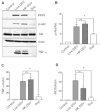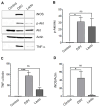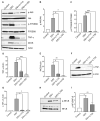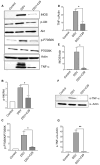Sulfate-Reducing Bacteria Induce Pro-Inflammatory TNF-α and iNOS via PI3K/Akt Pathway in a TLR 2-Dependent Manner
- PMID: 39338507
- PMCID: PMC11434237
- DOI: 10.3390/microorganisms12091833
Sulfate-Reducing Bacteria Induce Pro-Inflammatory TNF-α and iNOS via PI3K/Akt Pathway in a TLR 2-Dependent Manner
Abstract
Desulfovibrio, resident gut sulfate-reducing bacteria (SRB), are found to overgrow in diseases such as inflammatory bowel disease and Parkinson's disease. They activate a pro-inflammatory response, suggesting that Desulfovibrio may play a causal role in inflammation. Class I phosphoinositide 3-kinase (PI3K)/protein kinase B (AKT) signaling pathway regulates key events in the inflammatory response to infection. Dysfunctional PI3K/Akt signaling is linked to numerous diseases. Bacterial-induced PI3K/Akt pathway may be activated downstream of toll-like receptor (TLR) signaling. Here, we tested the hypothesis that Desulfovibrio vulgaris (DSV) may induce tumor necrosis factor alpha (TNF-α) and inducible nitric oxide synthase (iNOS) expression via PI3K/Akt in a TLR 2-dependent manner. RAW 264.7 macrophages were infected with DSV, and protein expression of p-Akt, p-p70S6K, p-NF-κB, p-IkB, TNF-α, and iNOS was measured. We found that DSV induced these proteins in a time-dependent manner. Heat-killed and live DSV, but not bacterial culture supernatant or a probiotic Lactobacillus plantarum, significantly caused PI3K/AKT/TNF/iNOS activation. LY294002, a PI3K/Akt signaling inhibitor, and TL2-C29, a TLR 2 antagonist, inhibited DSV-induced PI3K/AKT pathway. Thus, DSV induces pro-inflammatory TNF-α and iNOS via PI3K/Akt pathway in a TLR 2-dependent manner. Taken together, our study identifies a novel mechanism by which SRB such as Desulfovibrio may trigger inflammation in diseases associated with SRB overgrowth.
Keywords: Desulfovibrio vulgaris (DSV); inducible nitric oxide synthase (iNOS); phosphoinositide 3-kinase (PI3K)/protein kinase B (AKT) (PI3K/AKT); toll-like receptor 2 (TLR 2); tumor necrosis factor-α (TNF-α).
Conflict of interest statement
The authors declare no conflicts of interest.
Figures






Similar articles
-
Notch Signaling Pathway Is Activated by Sulfate Reducing Bacteria.Front Cell Infect Microbiol. 2021 Jul 15;11:695299. doi: 10.3389/fcimb.2021.695299. eCollection 2021. Front Cell Infect Microbiol. 2021. PMID: 34336718 Free PMC article.
-
Quercetin disrupts tyrosine-phosphorylated phosphatidylinositol 3-kinase and myeloid differentiation factor-88 association, and inhibits MAPK/AP-1 and IKK/NF-κB-induced inflammatory mediators production in RAW 264.7 cells.Immunobiology. 2013 Dec;218(12):1452-67. doi: 10.1016/j.imbio.2013.04.019. Epub 2013 May 9. Immunobiology. 2013. PMID: 23735482
-
Intestinal Alkaline Phosphatase Prevents Sulfate Reducing Bacteria-Induced Increased Tight Junction Permeability by Inhibiting Snail Pathway.Front Cell Infect Microbiol. 2022 May 26;12:882498. doi: 10.3389/fcimb.2022.882498. eCollection 2022. Front Cell Infect Microbiol. 2022. PMID: 35694541 Free PMC article.
-
Desulfovibrio in the Gut: The Enemy within?Microorganisms. 2023 Jul 7;11(7):1772. doi: 10.3390/microorganisms11071772. Microorganisms. 2023. PMID: 37512944 Free PMC article. Review.
-
Anti-inflammatory mechanisms of bioactive milk proteins in the intestine of newborns.Int J Biochem Cell Biol. 2013 Aug;45(8):1730-47. doi: 10.1016/j.biocel.2013.04.028. Epub 2013 May 6. Int J Biochem Cell Biol. 2013. PMID: 23660296 Review.
Cited by
-
Dose-dependent immunotoxic mechanisms of celastrol via modulation of the PI3K-Akt signaling pathway.Front Pharmacol. 2025 May 27;16:1567193. doi: 10.3389/fphar.2025.1567193. eCollection 2025. Front Pharmacol. 2025. PMID: 40495892 Free PMC article.
-
The Role of Bacteria-Derived Hydrogen Sulfide in Multiple Axes of Disease.Int J Mol Sci. 2025 Apr 3;26(7):3340. doi: 10.3390/ijms26073340. Int J Mol Sci. 2025. PMID: 40244174 Free PMC article. Review.
-
Strain-specific effects of Desulfovibrio on neurodegeneration and oxidative stress in a Caenorhabditis elegans PD model.NPJ Parkinsons Dis. 2025 Aug 11;11(1):236. doi: 10.1038/s41531-025-01102-z. NPJ Parkinsons Dis. 2025. PMID: 40790298 Free PMC article.
-
Desulfovibrio vulgaris exacerbates sepsis by inducing inflammation and oxidative stress in multiple organs.Front Microbiol. 2025 Apr 30;16:1574998. doi: 10.3389/fmicb.2025.1574998. eCollection 2025. Front Microbiol. 2025. PMID: 40371102 Free PMC article.
-
Activation of NR2A-Wnt-TLR2 Signaling Axis in Satellite Glial Cells of the Dorsal Root Ganglion Contributes to Neuropathic Pain Induced by Nerve Injury in Diabetic Mice.Mol Neurobiol. 2025 Jun;62(6):8013-8037. doi: 10.1007/s12035-025-04754-3. Epub 2025 Feb 18. Mol Neurobiol. 2025. PMID: 39964585
References
-
- Dzierzewicz Z., Szczerba J., Lodowska J., Wolny D., Gruchlik A., Orchel A., Weglarz L. The role of Desulfovibrio desulfuricans lipopolysaccharides in modulation of periodontal inflammation through stimulation of human gingival fibroblasts. Arch. Oral Biol. 2010;55:515–522. doi: 10.1016/j.archoralbio.2010.05.001. - DOI - PubMed
Grants and funding
LinkOut - more resources
Full Text Sources

